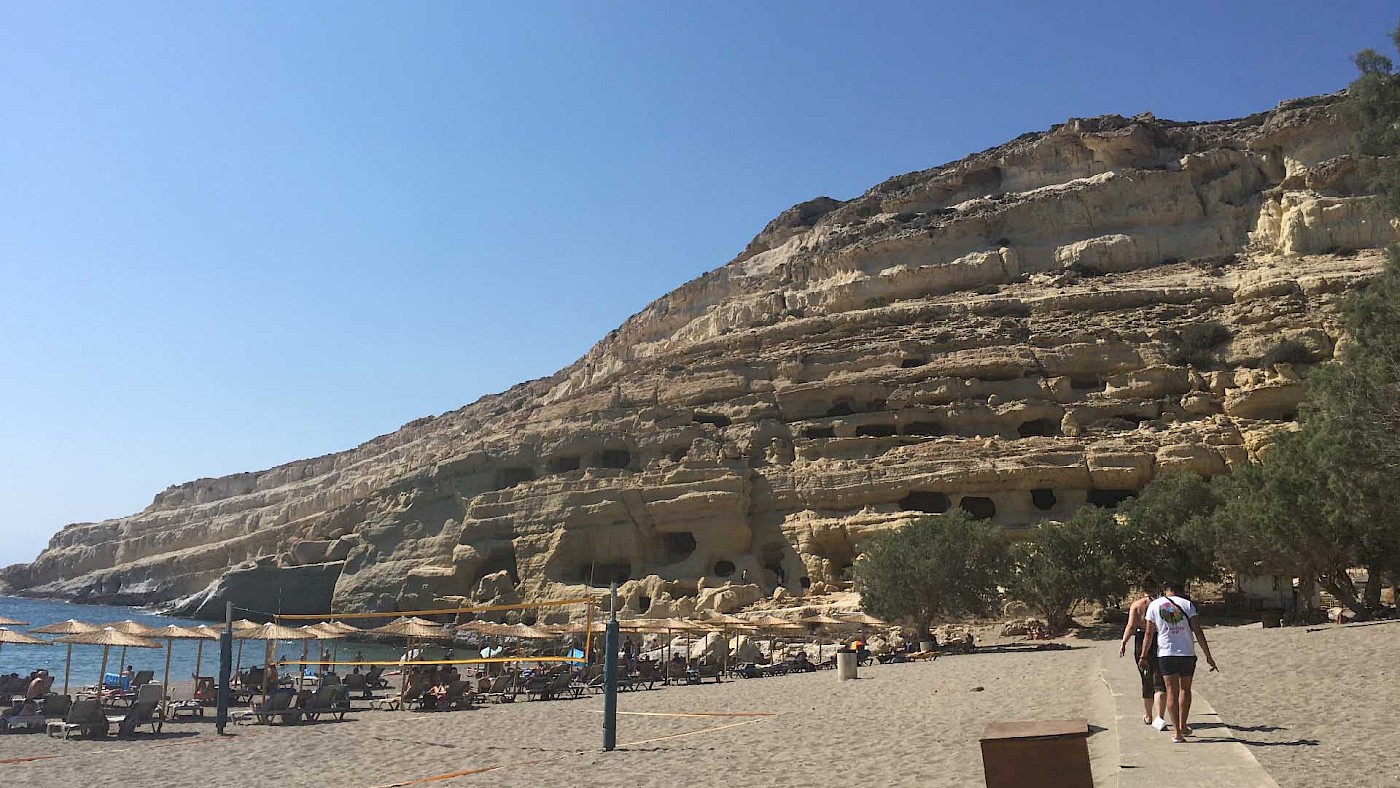The island of Crete has many coastal settlements with excellent beaches. One of these is Matala, located on Crete’s southern coast and physically separated from the surrounding coastline by imposing limestone formations that seem to rise up at an angle from the sea.
The northern cliff along the beach resembles Swiss cheese, featuring as it does a large number of smaller and larger cavities. These are not naturally formed, but man-made “caves” that have been cut into the limestone. While some claim that these caves date back to the Neolithic, the descriptive plaque at the site itself identifies them as Roman tombs. Certainly, anyone familiar with rock-cut funerary architecture will recognize familiar features, including benches, spots for lamps on the walls, and, for the most part, relatively small entrances.
Some guidebooks claim that these artificial caves were also used as houses, but this was clearly not the case. Aside from the fact that the houses of the living are normally kept quite separate from the houses of the dead, these rock-cut rooms are generally too small to comfortably house a family, and they generally consist of only a single chamber, often with a ceiling too low to permit an adult to stand upright.

Still, there was a period when these caves were used for domestic purposes. In the 1960s, hippies moved to Matala and took up residence in the tombs. Canadian singer-songwriter Joni Mitchell spent time here with Cary Raditz, who worked at a local taverna and about whom she wrote the song “Carey” (1971), with an extra E. In the song, Mitchell mentions how “they’re playin’ that scratchy rock and roll, beneath the Matala moon”.
In many ways, the hippie spirit never left Matala: for the modern visitor, too, there is something of the happy-go-lucky atmosphere of that bygone era that still permeates the air, reinforced by colourful murals and streetpaintings, as well as the general laissez-faire attitude of the people who work here and visit the town. (Few people actually live in Matala; most who work in the tourism industry here live in other towns nearby, such as Pitsidia. In winter, the town is practically deserted.)
Some of the caves or loculi at Matala are in fairly good condition, but most of them bear the scars from centuries of visitors, including the taijitu (yin yang) symbol and various names and words (like “Freedom”) that have been scratched into the relatively soft stone. Erosion has also caused some of the walls of certain caves to collapse, exposing the interiors. These open spaces have essentially become balconies that offer an excellent view of the bay.
The area with the tombs is today an official archaeological site, fenced off and equipped with a ticket booth. A sign at the entrance informs the visitor that the paths are treacherous and you proceed at your own risk. Indeed, if you visit the site, you better wear something more sturdy than flip flops, and be prepared to clamber around on the rocks to reach the harder-to-reach, but often better preserved caves.

The caves date from the Roman period based on the style of the tombs. Metellum, as the town was known to the Romans, from the Greek name Metallon, was an important point on the trade route between Alexandria and Rome. In Roman times, Metellum also served as the harbour of Gortyn, which lay further inland and was the most important town on the island of Crete during this period.
But the history of Matala stretches back further. It was already a flourishing town from the fourth century BC onwards, especially during the Hellenistic era. Archaeology has revealed that while town engaged in some farming, it was mostly focused on industrial activities, including mining, quarrying, fishing, and more. Indeed, the stone from the Matala headland and surrounding region was used by builders for local construction from the Bronze Age onwards.
According to local legends, Matala is the place where Zeus came ashore after he had abducted the Phoenician princess Europa, disguised as a white bull. Europa would lend her name to the continent on which she found herself. I haven’t been able to verify this story, but I think Matala, with its sandy beach, impressive rock formations, and relaxed atmosphere, on the edge of the feritile Messara Plain, makes for a good entrypoint to the island.
Matala is a wonderful place to spend some time, located not far from the archaeological sites of Phaistos, Agia Triada, and Kommos. The sea is pleasant and the beach comfortable. If that doesn’t tickle your fancy, you can get some excellent food here. I recommend the family-run seafood restaurant Scala, which has a breathtaking view of the beach and bay from its rocky perch opposite the Roman tombs.
Further reading
- John A. Gifford and David S. Reese, “The physical geology of the western Mesara and Kommos”, in: Joseph W. and Maria C. Shaw (eds), Kommos: An Excavation on the South Coast of Crete, Volume I (1995), pp. 30-90.
- George W.M. Harrison, “Crete the ordinary”, in: W.G. Cavanagh and M. Curtis (eds), Post-Minoan Crete: Proceedings of the First Colloquium on Post-Minoan Crete held by the British School at Athens and the Institute of Archaeology, University College London, 10-11 November 1995 (1998), pp. 129-134
